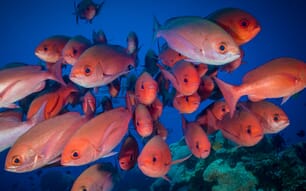Four months earlier, at the beginning of June, the MU research specialist had stocked the pond with 4,000 juvenile freshwater prawns bought from a Texas hatchery. Freshwater prawns are a species of shrimp native to Malaysia, which has a tropical climate very different from that of mid-Missouri.
Summer and fall had been cool in Missouri this year. Raccoons and frogs were using the pond as an all-you-can-eat buffet. How many prawns had survived, and how big were they? Mr Wright wouldn't know until the pond was more than half-empty.
"There's a tremendous amount of risk involved," he said. "Corn and beans-Missouri farmers know how to grow them. They know the risks and they know how to manage them."
When it comes to raising seafood in Missouri, however, producers are still learning what works and what doesn't. "With prawns, when the temperature goes below 60, you've lost your crop," Mr Wright said. "You don't want to learn that after you've invested $10,000. You want someone else to learn that, so you know that when the temperature gets in that range, it's time to get the prawns out."
"Raising aquatic species for profit is an agricultural endeavor that requires special skills, knowledge and dedication to be successful," said Charles Hicks, aquaculture specialist at Lincoln University. "It's critical that potential producers do their homework."
Making that homework a little easier is why MU and Lincoln University are partners in research and extension programming aimed at supporting the development of a thriving aquaculture industry in Missouri.
"The focus is on practical, cost-effective techniques for raising species such as prawns, bluegill sunfish and largemouth bass for food markets in the Midwest," said Bob Pierce, MU Extension fisheries and wildlife specialist.
The US imports more than 80 per cent of its seafood. At the same time, Americans are increasingly interested in fresh, locally grown food. Can Missouri help meet the demand for domestic fish and shellfish?
The state has more than 300,000 acres of farm ponds, notes Leslie Hearne, an MU graduate student in fisheries and wildlife sciences. Those ponds could become a rich source of protein and profit, she said.
Ms Hearne is doing research at Lincoln University's Carver Farm, which has an aquaculture facility that includes more than 20 quarter-acre and tenth-acre ponds as well as indoor tanks for breeding and hatching fingerlings.
"We're trying to develop a fast-growing strain of bluegill that can get to market in less than two years," she said. Bluegill, a native sunfish common to Missouri farm ponds, typically takes about three years to grow to a marketable weight of about half a pound.
Researchers also are developing diets and feeding schedules to maximise bluegill growth while minimising the amount of food they need. According to Mr Pierce, reducing the cost of producing marketable food-grade bluegill could make the fish a competitive local alternative to popular aquaculture species such as tilapia.
Keeping costs down was why Wright took a mostly low-tech approach to his freshwater prawn project. "We don't want to spend $10,000-$20,000 on aeration systems and meters even though it might help, because most farms are not going to have that," he said. "We want to have something they already have in place."
Mr Wright knew he was cutting it close with his late-September harvest, so he was relieved when prawns started gushing out of the pond's outlet pipe by the dozen. He ended up collecting more than 2,700 prawns, which were packed in ice, shipped to the MU campus and served that night to hundreds of students who had the rare opportunity to enjoy fresh-caught Missouri seafood.
Eric Cartwright, executive chef for MU Campus Dining Services, jumped at the chance to buy Mr Wright's prawns. "As a chef and as a food lover, the prospect of getting some fresh prawns made me super-excited," he said. "When you get a product that was literally swimming that morning, the fresh flavour you can get from that is hard to describe."
Mr Cartwright isn't the only one excited about Missouri aquaculture.
"When we have tours at the farm, it always gets attention," Mr Wright said. "Everyone's excited about fish. When we ask if they want to see fish production, all the hands go up. That should tell you something."
Locally Produced Seafood A Possibility?
US - Attemping to produce freshwater prawns at the University of Missouri (MU, Ray Wright hopes to encourage local seafood production.


